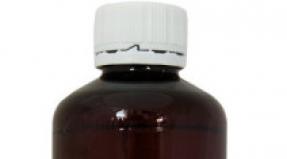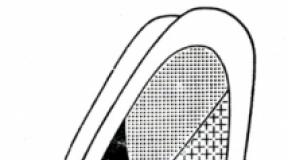Salicylic acid and its derivatives. Salicylic acid derivatives Salicylic acid derivative for the treatment of rheumatism
Page 1
Salicylic (o-hydroxybenzoic) acid (Acidum salicylicum) is one of the three isomeric hydroxybenzoic acids belonging to the group of phenolic acids. It got its name from the Latin name for the willow - Salix. The bark of willow contains the glycoside salicin, the hydrolysis of which yields the phenolic alcohol saligenin C6H4 (OH) CH2OH. Salicylic acid is obtained by oxidation of saligenin:
C6H4 (OH) CH2OH Ü C6H4 (OH) COH Ü C6H4 (OH) COOH
saligenin salicylic salicylic
aldehyde acid
Currently, salicylic acid is produced commercially by the direct carboxylation of phenol with carbon dioxide (Kolbe reaction). Carbon dioxide is a weak electrophilic reagent; therefore, for the reaction to occur, it is necessary to enhance the nucleophilic properties of the substrate. In this regard, the reaction is carried out not with phenol itself, but with its sodium salt, since the phenoxide ion is a stronger nucleophile than phenol. The reaction is carried out in autoclaves with heating under pressure. Then the reaction mixture is acidified and salicylic acid is isolated:
С6H5-ONa + CO2 Ü C6H5-OH Ü С6H4-OH
sodium phenolate ê ½
salicylate salicylic
sodium acid
Salicylic acid is a colorless crystal, mp 159 ° C, hardly soluble in cold water. When heated, salicylic acid is easily decarboxylated to form phenol:
С6H4 (OH) COOHÜC6H5OH + CO2
salicylic acid phenol
Salicylic acid has an intramolecular hydrogen bond that stabilizes the carboxylate ion, which leads to an increase in its acidity (pKa 2.98) compared to benzoic (pKa 4.20) and p-hydroxybenzoic (pKa 4.58) acids.
Salicylic acid gives a violet color with FeCl3 not only in aqueous, but also in alcoholic solution (in contrast to phenol).
Under the action of an alkali metal hydroxide, salicylic acid dissolves to form a phenolate salt of an alkali metal, for example:
C6H4-COOH + 2 NaOH Ü C6H4-COONa + 2 H2O
sodium phenolate
When alkali metal carbonates act on salicylic acid, different degrees of acidity of carboxyl and phenolic hydroxyl are manifested; when this occurs the formation of salts. The carboxyl group of salicylic acid decomposes alkali metal carbonates, displacing weak carbonic acid, while phenolic hydroxyl, which has weaker acidic properties than carbonic acid, is unable to decompose these salts and therefore remains free:
2 C6H4-COOH + Na2CO3Ü 2 C6H4-COONa + H2O + CO2
sodium salicylate
Salicylic acid, like all phenolic acids, is also capable of nitrating, sulfonating, halogenated with the replacement of hydrogen atoms in the benzene nucleus.
Salicylic acid is used in the production of dyes, medicinal and aromatic substances, in the food industry (for canning), as an analytical reagent. Salicylic acid is widely used in medicine. It has antirheumatic, antipyretic and antifungal effects, but as a strong acid it irritates the digestive tract and is therefore only used externally. Inside, its derivatives are used - salts or ethers.
Salicylic acid is capable of giving derivatives at each functional group.
C6H4 (OH) COOH ® C6H4 (OH) COONa
Studies of cadmium electrolytes
Cd is a rather soft metal of a silvery-white color somewhat harder than tin but softer than zinc; it is rolled into sheets, well forged and easily polished. Clean, free from ...
Organosilicon polymers
An organic substance is called a polymer, long molecules of which are built from the same repeating units - monomers. The size of a polymer molecule is determined by the degree ...
Processing of polymeric materials
At present, it is envisaged to further improve the service of the country's population by all types of transport, including rail transport. The solution to this problem may not ...
n-Aminobenzoic acid (PABA) and its derivatives. Esters of aromatic amino acids are capable of causing local anesthesia to one degree or another. This property is especially noticeable in the para-derivatives. In medicine, anesthesin (PABA ethyl ether) and novocaine (PABA 2-diethylaminoethyl ether) are used. Novocaine is used in the form of a salt (hydrochloride), due to the need to increase its solubility in water.
Anestezin is one of the very first synthetic compounds used as local anesthetics. Despite its more than 100-year existence (synthesized in 1890; used since the late 90s), it is still relatively widely used independently and in combination with other drugs. Recently, a new aerosol preparation "Amprovizol" containing anesthesin was proposed. Anestezin is an active surface local anesthetic. Due to the difficult solubility in water, the drug is not used parenterally and for anesthesia during surgical operations. However, it is widely used in the form of ointments, powders and other dosage forms for urticaria, skin diseases accompanied by itching, as well as for pain relief of the wound and ulcerative surface. Apply 5 - 10% ointment or powder and finished medications ("Menovazin", "Amprovizol", etc.). Novocaine (procaine hydrochloride) is an ester of diethylaminoethanol and para-aminobenzoic acid. In medical practice, it is used in the form of hydrochloride. It has a fairly pronounced anesthetic activity, but is inferior in this regard to other drugs. The duration of infiltration anesthesia is 30 min-1 h. The great advantage of novocaine is its low toxicity. This also applies to its metabolites. Novocaine passes through the mucous membranes poorly, therefore, it is rarely used for surface anesthesia (sometimes for these purposes it is used in otorhinolaryngology in high concentrations - 10% solutions). Novocaine, unlike cocaine, does not constrict blood vessels. Their tone does not change or slightly decreases, therefore adrenergic agonists (for example, adrenaline) are often added to novocaine solutions. Narrowing blood vessels and slowing down the absorption of novocaine, adrenomimetics enhance and prolong its anesthetic effect, and also reduce its toxicity. With a resorptive effect, novocaine has a predominantly depressing effect on the nervous system. It has a moderate analgesic activity. In high doses, it can cause convulsions. The effect of novocaine on the cardiovascular system is manifested by a hypotensive effect (the result of a depressing effect of the drug on the central nervous system and sympathetic ganglia), as well as a short-term antiarrhythmic effect (the effective refractory period and the time of conduction along the conduction system of the heart increase, excitability and In the body, novocaine is quickly hydrolyzed by plasma and tissue esterases. Its main metabolites are diethylaminoethanol and para-aminobenzoic acid. It should be borne in mind that the latter is a competitive antagonist of antibacterial agents from the sulfonamide group. The conversion products of novocaine are excreted by the kidneys.
Salicylic acid and its derivatives. Salicylic acid belongs to the group of phenolic acids. As an ortho-functional compound, it decarboxylates on heating to form phenol.
Salicylic acid is moderately soluble in water, gives intense coloration with ferric chloride (III), which is the basis for the qualitative detection of the phenolic hydroxyl group. Salicylic acid exhibits antirheumatic, antipyretic and antifungal effects, but as a strong acid (pKa 3.0) it irritates the gastrointestinal tract and is therefore only used externally. Inside, its derivatives are used - salts or ethers. Salicylic acid is capable of forming derivatives at each functional group. Of practical importance are sodium salicylate, esters for the carboxyl group - methyl salicylate, phenyl salicylate (salol), as well as for the hydroxyl group - acetylsalicylic acid (aspirin).
The listed derivatives (except for salol) have analgesic, antipyretic and anti-inflammatory effects. Methyl salicylate, due to its irritating effect, is used externally as part of ointments. Salol is used as a disinfectant for intestinal diseases and is notable for the fact that it does not hydrolyze in the acidic environment of the stomach, but decomposes only in the intestine. In this regard, salol is also used as a material for the protective membranes of some drugs that are unstable in the acidic environment of the stomach. Salicylic acid was first obtained by oxidation of salicylic aldehyde contained in the meadowsweet plant (genus Spireae). Hence its original name - spic acid, with which the name aspirin is associated (the initial letter "a" stands for acetyl). Acetylsalicylic acid has not been found in nature.
33. Heterocycles with one heteroatom. Pyrrole, indole, pyridine, choline. The concept of the structure of tetrapyrrole compounds (porphin, heme). Pyridine derivatives (nicotinamide, pyridoxal). 8-hydroxyquinoline derivatives: antibacterial complexing agents.
The most important representative of five-membered heterocycles with one heteroatom is pyrrole. Pyrolic compounds include a condensed indole system and a completely saturated analogue of pyrrole, pyrrolidine, which are part of the complex molecules of chlorophylls, blood gem and alkaloids, such as nicotine and tropane. Thus, the structure of gem and chlorophylls is based on the tetrapyrrole system of porphin.
Pyrrole.(C4H5N) Pyrrole belongs to aromatic compounds. The carbon and nitrogen atoms in it are in a state of sp2 hybridization. There is a lone pair of electrons on the non-gyribidized p-orbital of the nitrogen atom. It participates in conjugation with the p-electrons of four carbon atoms to form a single six-electron cloud. Three sp2-hybrid orbitals form three σ-bonds - two with carbon atoms, one with hydrogen atoms. The nitrogen atom in this state is called pyrrole.
Indole.(C8H7N) Indole is acidophobic and practically devoid of basic properties. Indole is a structural fragment of the protein amino acid tryptophan and the products of its metabolic transformations, tryptamine (C10H12N2) and serotonin (N2OC10H12), which are biogenic amines. Many synthetic indole derivatives are used in medicine, for example, indopane.
Pyridine.(C5H5N) The representative of aromatic heterocycles exhibits the properties of aromatic compounds. Homologues of pyridine are readily oxidized to the corresponding pyridinecarboxylic acids. The oxidation of isomeric methylpyridines is of great importance. The basicity of pyridine is higher than that of aromatic amines, but lower than that of aliphatic ones. This is due to the fact that the lone pair of electrons of the nitrogen atom occupies the sp2-hybrid orbital. Pyridine can react with nucleophilic reagents. The structure of fully saturated pyridine - piperidine underlies the analgesic promedol. The most important pyridine derivatives are some B vitamins, which act as structural elements of coenzymes.
The planar porphin macrocycle is a conjugated aromatic system of 26 π-electrons. The substituted porphins are called porphyrins, one of which is protoporfin. Porphyrins are naturally found in the form of complexes with metal ions. Porphyrin derivatives containing iron ion 3 are called hemes. An example would be protoheme - the prosthetic group of hemoglobin.

thrombi formed under the action of peptizers.
Choline- a vitamin-like substance that regulates fat metabolism.
OH - CHOLINE
choline, part of phospholipids
The source of pyridine and its homologues (2-, 3- and 4-methylpyridines - picolines) is mainly natural raw materials. Therefore, synthetic methods for the preparation of pyridine derivatives are few. The pyridine ring is part of nicotinamide (vitamin PP, XX), the group of compounds united by the common name vitamin B6 includes pyridoxal (R \u003d CHO) and pyridoxamine (R \u003d CH2NH2) (XXI). Pyridoxal-5-phosphate serves as a coenzyme for decarboxylation and transamination of α-amino acids. Nicotine (toxic tobacco alkaloid, XXII), nicotinamide adenine dinucleotide (NADP, XXIII), as well as many other biologically active natural compounds, synthetic drugs and plant protection products contain a pyridine nucleus.
Nicotinic acid and its amide - nicotinamide- are known as two forms of vitamin PP. Nicotinamide is an integral part of enzyme systems responsible for redox processes in the body, and niacin diethylamide is cordiamine- serves as an effective stimulant of the central nervous system.
34. Heterocycles with several heteroatoms. Pyrazole, imidazole, pyrazine, pyrimidine, thiazole, purine. Barbituric acid and its derivatives. Hydroxypurines (xanthine, uric acid, vitamin B1).
Five-membered heterocycles with two heteroatoms, one of which is nitrogen, are collectively called azoles. The most important representatives are pyrazole, imidazole, pyrazine, pyrimidine, thiazole, purine.
Pyrazole. (C3H4N2O) Pyrazole derivatives have not been found in nature. The most famous pyrazole derivative is pyrazolone. On the basis of pyrazolone, analgesics have been created - analgin, butadion, etc.
Imidazole. (C3H4N2) This heterocycle is a structural fragment of the protein amino acid histidine and the product of its dicarboxylation - the biogenic amine of histamine. Imidazole condensed with a benzene ring - benzimidazole - is a part of a number of natural substances, in particular vitamin B12, as well as the vasodilating agent dibazole.
Pyrazine. (C4H4N2) Six-membered heterocyclic organic compound with two nitrogen atoms. Aromatic. Let's well dissolve in water, ethanol, ethoxyethane. It enters into reactions of nucleophilic and electrophilic substitution. When aminated with sodium amide in liquid ammonia, it is converted to 2-aminopyrazine. When oxidized with a mixture of acetic anhydride - hydrogen peroxide, it gives N-oxides in one or both nitrogen.
Pyramidine. (C4N2H4) Heterocyclic compound having a planar molecule, the simplest representative of 1,3-diazines. Pyrimidine derivatives are widespread in nature, where they are involved in many important biological processes. In particular, derivatives such as cytosine, thymine, uracil are part of the nucleotides, which are the structural units of nucleic acids, the pyrimidine core is part of some B vitamins, in particular B1, coenzymes and antibiotics. The pyrimidine structure, both aromatic and hydrogenated, is a part of many biologically active substances and drugs - for example, barbiturates - derivatives of 1,3,5-trihydroxypyridine, which have hypnotic, anticonvulsant and narcotic effects.
Thiazol. (C3H3SN) The thiazole ring contains two different heteroatoms. The structure of tazol is found in the composition of important biologically active substances - thiamine and a number of sulfa drugs, for example, the antimicrobial agent phthalosol. The fully hydrogenated thiazole cycle - thiazolidine - is a structural fragment of penicillin antibiotics.
Purine. (C5N4H4) The simplest representative of imidazopyrimidines. Colorless crystals, readily soluble in water, hot ethanol and benzene, poorly soluble in diethyl ether, acetone and chloroform. Purine derivatives play an important role in the chemistry of natural compounds (purine bases of DNA and RNA; coenzyme NAD; alkaloids, caffeine, theophylline and theobromine; toxins, saxitoxin and related compounds; uric acid) and, therefore, in pharmaceuticals.
Derivatives of pyramidin include barbituric acid, which can exist in several tautomeric forms. In the crystalline state, barbituric acid has a trioxide structure, which also prevails in solution. Barburic acid easily forms salts when exposed to alkalis. Its high acidity is due to the effective delocalization of the negative charge in the barbiturate ion with the participation of two oxygen atoms.


Barbituric acid. It is a cyclic ureide of malonic acid. M \\ b is obtained by the interaction of malonic ether with urea, in the presence of sodium ethoxide. An important role in the quality of hypnotics and anticonvulsants is played by barbiturates (5,5-disubstituted derivatives of this acid). They are obtained as B. acid using disubstituted esters of malonic acid. They readily give water-soluble salts with an alkali equivalent. Examples: Barbital (5.5 diethylbarbituric acid), Barbital sodium, phenobarbital (5-ethyl-5-phenylbarbituric acid) (luminal).
Thiamin (vitamin B 1) is one of the most important vitamins. A lack of vitamin B 1 leads to a disease known as beriberi. The need for this vitamin is due to the fact that it is included in the structure of the coenzyme cocarboxylase

Hydroxypurines - 6-hydroxypurine (hypoxanthine), 2,6-dihydroxypurine (xanthine) and 2,6,8-hydroxypurine (uric acid) - are formed during the metabolism of nucleic acids in the body. In hydroxypurines, lactim-lactam tautomerism and migration of the hydrogen atom at positions 7 and 9 are possible. Uric acid is the end product of the metabolism of purine compounds in the body. M. acid is dibasic, poorly soluble in water, but readily in alkalis, forming salts with alkali. Salts of M. acid are called urates. With some disorders in the body, they are deposited in the joints, for example, with gout, as well as in the form of kidney stones. Xanthine and hypoxanthine are similar to uric acid. Amphoteric, form salts with alkalis and acids. N-methyl-substituted xanthine derivatives are alkaloids.


The site provides background information for informational purposes only. Diagnosis and treatment of diseases must be carried out under the supervision of a specialist. All drugs have contraindications. A specialist consultation is required!
Salicylic acid - descriptive characteristic
Salicylic acid known to many, it is often present in the home medicine cabinet. This drug brings many benefits, but is cheap. This pharmacological agent is used to treat many diseases, but, like any medicinal product, it also has its own contraindications for use.It was first obtained from the bark of the willow Salix L., and then the German chemist Kolbe managed to synthesize salicylic acid in a simple way, which is still used today. Initially, salicylic acid was used to treat rheumatism, but with the advent of modern antirheumatic drugs, it is used only as a means for external use. Refers to non-steroidal anti-inflammatory drugs.
Composition and form of release
The active substance is orthoxybenzoic acid.The product is available in the following dosage forms:
- Salicylic acid 1% solution, bottles of 25 and 40 ml.
- Salicylic acid 2% solution, bottles of 25 and 40 ml.
- Salicylic ointment 2%, bank 25 g.
- Salicylic acid alcohol solution 1%, vials of 25 and 40 ml.
- Salicylic acid alcohol solution 2%, vials of 25 and 40 ml.
- Salicylic acid alcohol solution 3%, bottles of 25 and 40 ml.
- Salicylic acid alcohol solution 5%, bottles of 25 and 40 ml.
- Salicylic acid alcohol solution 10%, vials 25 and 40 ml.
- Salicylic petroleum jelly 1%, tube 30 ml.
- Salicylic-zinc paste (Lassar paste), can of 30 ml.
Pharmacological action of drugs
Salicylic acid corresponds to the following formula: C 7 H 6 O 3 \u003d C 6 H 4 (OH) - CO 2 N. It is a representative of the group of aromatic hydroxy acids. In the adjacent positions of the benzene ring, it has an OH group, like phenol, and a COOH group, like benzoic acid. This compound is widespread in nature.Salicylic acid is recommended to be used externally as a distracting, local irritating, anti-inflammatory, keratoplastic, keratolytic, drying and antiseptic agent.
At a sufficient concentration, salicylic acid is capable of coagulating microbial proteins. When applied, it has a pronounced effect on sensitive nerve endings. In addition, it improves trophism, reduces pain.
The tool has the ability to suppress the secretion of not only sebaceous, but also sweat glands. When using low concentrations, keratoplastic action takes place, and high concentrations of the solution - keratolytic action of the drug. Weak antimicrobial activity is noted.
Powders
In powders (2-5%), salicylic acid is used for excessive sweating of the legs, hyperhidrosis. Galmanin powder contains 2 parts of salicylic acid, 10 parts of zinc oxide and 44 parts of talc.
Corn adhesive "Salipod"
The plaster is fixed on the skin and kept for two days. Reapplication is recommended until the callus disappears.
Persalan
It is used as a hair strengthening agent. It is a liquid. It is applied to the hair, the head is insulated with a towel. After 30 minutes, wash your hair with warm water. Used to treat oily seborrhea.
Salicylic acid derivatives
 Salicylic acid preparations are used as classic antirheumatic drugs. They have antipyretic, anti-inflammatory, analgesic effects.
Salicylic acid preparations are used as classic antirheumatic drugs. They have antipyretic, anti-inflammatory, analgesic effects. When taken orally, salicylic acid can cause irritation of the gastric mucosa; therefore, its sodium salt is often used.
The agent is quickly excreted from the body through the kidneys, as well as sweat glands. Salicylic acid salts are of low toxicity. However, due to the fact that salicylates in the treatment of rheumatism are prescribed in very large doses, they can cause side effects: shortness of breath, tinnitus, skin rashes.
Salicylic acid solutions are practically incompatible with resorcinol, since melting mixtures are formed in the case of their interaction. When interacting with zinc oxide, insoluble zinc salicylate is formed, therefore, the use of salicylic acid with it is not recommended.
Side effects
With local application of salicylic acid, burning, itching, hyperemia at the site of exposure may occur. Allergic reactions may occur, individual intolerance to the active substance is rarely possible.special instructions
It is not recommended to apply salicylic acid preparations to birthmarks, genital or facial warts, or hairy warts. When treating children, it is not recommended to treat several skin surfaces at the same time. Children under 3 years of age are not recommended to use salicylic acid preparations and its derivatives.During pregnancy, it is allowed to use products containing salicylic acid for the treatment of corns only on a limited surface.
The mucous membranes must be flushed with plenty of water if even a small amount of salicylic acid preparations has gotten on them.
It should be borne in mind that an increase in the absorption of salicylic acid is possible in some skin diseases, especially those that occur with hyperemia, inflammation or with weeping eczematous skin lesions: dermatitis, psoriasis, eczema, ichthyosis.
Application for various pathologies
Salicylic acid and its derivatives are used in the treatment of many diseases and various skin manifestations in various fields of medicine.In dermatology
 Salicylic acid and its preparations have a strong exfoliating effect on the skin, therefore it is successfully used in the effective treatment of simple acne. The action of the product is based on softening the top layer of the skin and follicle plugs, which prevents the formation of comedones.
Salicylic acid and its preparations have a strong exfoliating effect on the skin, therefore it is successfully used in the effective treatment of simple acne. The action of the product is based on softening the top layer of the skin and follicle plugs, which prevents the formation of comedones. Most often, 1 and 2% alcohol solutions of salicylic acid, the so-called salicylic alcohol, are used. Higher concentrations of solutions are not used to treat acne and acne.
Salicylic acid is also used in the treatment of skin diseases. It is a part of many finished medicines: creams, gels, shampoos, lotions. Means of the Klerasil and Sebium AKN series are effective. Complex medical prescriptions for the treatment of skin diseases are popular.
Typically, salicylic acid medications are used for rubbing once (in the morning) to twice a day. When using low concentrations of solutions, side effects, such as irritation and redness of the skin in the affected area, are not observed.
People with sensitive skin often experience dryness caused by the action of salicylic alcohol. The basic rule must be observed: do not apply salicylic alcohol to the skin after cleansing it with alcoholic lotions, gels, scrubs. It is also not recommended to use salicylic acid preparations together with benzoyl peroxide.
Treatment of warts with salicylic acid
To get rid of warts, the "Salipod" patch is used, which contains salicylic acid.
Application: stick the patch on the wart area for two days. Then it is removed. The wart is soaked in hot water and the top layer is removed. This procedure is repeated several times until the warts disappear completely.
Salicylic acid solution can be used successfully instead of a patch. They moisten the surface of the wart with a cotton pad, which can be left on the wart until it dries completely. This procedure will have to be repeated more than once.
Elimination of age spots
Often, after squeezing out acne, age spots remain on the skin, bringing many tears to young girls. Psychological discomfort in this case often becomes the cause of self-doubt. At home, you can wipe your face with salicylic alcohol. Some people prefer to visit a beauty salon. There, experts will help to eliminate age spots with the help of whitening masks based on salicylic acid and bodyagi.
Salicylic acid for psoriasis
For the treatment of psoriasis, salicylic acid is used as a topical therapy.
In cosmetology
 The unusually effective effect of salicylic acid on skin cells has long been proven. As already mentioned, it has anti-inflammatory, exfoliating and keratolytic effects, which makes it suitable for use in cosmetology.
The unusually effective effect of salicylic acid on skin cells has long been proven. As already mentioned, it has anti-inflammatory, exfoliating and keratolytic effects, which makes it suitable for use in cosmetology. With its strong antibacterial effect, salicylic acid is rightfully considered a thunderstorm of acne.
Salicylic acid is used to remove warts, calluses, callosities, and is used against dandruff and acne. It can be found in many beauty products.
As you know, the use of Salicylic acid has a number of advantages:
- effectively helps from pimples, comedones, as it freely penetrates into the sebaceous glands, dissolves sebum;
- improves skin regeneration;
- does not affect the normal microflora of the skin;
- inhibits the aging process of the skin;
- does not suppress the immune system;
- suitable for problematic, sensitive and oily skin;
- does not increase skin photosensitivity;
- cosmetics with salicylic acid can be used daily.
Peeling is used for acne, photoaging, post-acne, seborrheic dermatitis, demodicosis.
Peeling is carried out by applying the mixture to the skin for a few minutes, lightly massaging the facial lines and removing it with a cotton pad. Finally, rinse the skin surface with warm water.
Salicylic acid preparations should not be used in children's cosmetics, with the exception of shampoos.
Preservative properties of salicylic acid
Salicylic acid is not an effective preservative, but its effect is much stronger against yeast than against bacteria. As a preservative, salicylic acid has found application in various dermatological preparations, less often in cosmetic products.There is information about the use of salicylic acid for household purposes as a preservative. Sometimes it is used in the manufacture of homemade products: compotes, canning
Page 59 of 81
Salicylic acid - orthoxybenzoic acid - has carboxyl and hydroxyl attached to the benzene ring and located in the ortho position to each other.
Due to the addition to the carboxyl group, salts, esters and esters of salicylic acid are formed, due to the addition of organic acids to the hydroxyl residue - the esters of these acids. All these compounds have a common name - salicylates.
Acetylsalicylic acid (aspirin) - otherwise the salicylic ester of acetic acid. One of the most popular pain relievers and antipyretics, acetylsalicylic acid, alone or in combination with another analgesic drug and caffeine, is widely used as a headache remedy. It also has an analgesic effect on neuralgia and myalgia. It is an effective pain reliever for moderate pain; like other analgesics-antipyretics, in terms of the strength of the analgesic effect, it cannot be compared with morphine and its substitutes, especially for pain in the chest and abdomen and for acute traumatic pain. Due to the differences in the mechanisms and nature of the analgesic action of acetylsalicylic acid and narcotic analgesics, it is difficult to quantitatively compare them in terms of the strength of this action. We can only say that the analgesic effect of acetylsalicylic acid is approximately 10 times weaker than the analgesic effect of one of the weakest opium analgesics - codeine.
The big advantage of acetylsalicylic acid over opiates is the absence of euphoria, addiction and addiction.
In the central analgesic effect of acetylsalicylic acid, like other non-narcotic analgesics, the main role is played by the effect on the hypothalamic and other centers of the deep structures of the brain. Their influence on the cerebral cortex and the reticular formation is insignificant, and, applied in doses sufficient for the manifestation of the maximum analgesic effect for these agents, they do not cause drowsiness and confusion. In addition to the action on the centers of the brain, in the analgesic effect of acetylsalicylic acid and other analgesics, their peripheral action plays a certain role. According to the authors involved in the exchange of prostaglandins, the analgesic effect of acetylsalicylic acid codeines, the concentration of which increases during inflammation and irritates sensitive endings. Acetylsalicylic acid, like other non-narcotic analgesics, has antipyretic effects. It lowers body temperature in feverish animals and humans and does not affect normal body temperature.
As mentioned above, this is due to its antagonism with pyrogenic substances. By displacing pyrogens from the receptors of the neurons of the thermoregulatory centers, acetylsalicylic acid frees these centers from the influence of pyrogen and returns them to their normal response to increased body temperature.
Acetylsalicylic acid, like other salicylates, is successfully used as an anti-inflammatory agent, while the main pathological process does not decrease, but only inflammation decreases. The secretion of corticosteroids, hormones of the adrenal cortex, takes some part in this, but this is not the main reason for the anti-inflammatory action of acetylsalicylic acid and other salicylates, since it is manifested in animals with removed adrenal glands. Various researchers point to the involvement of various peripheral mechanisms in the anti-inflammatory action of salicylates. According to the most convincing data, a significant role in this is played by the effect of salicylates on metabolic processes in connective tissues, including inhibition of prostaglandin synthesis.
In the general action of salicylates, their interference in oxidative processes plays an important role. Salicylates belong to the so-called uncoupling poisons, which uncouple the oxygen consumption by tissues and the oxidative phosphorylation that occurs in them. Oxygen consumption under the influence of salicylates increases without a corresponding increase in oxidative phosphorylation. Due to this, under the action of sufficiently large doses of salicylates, as well as under the action of other "uncoupling" substances, such as dinitrophenol, oxygen deficiency and excess carbon dioxide in the blood are formed, which, in turn, leads to acidosis and excitation of the respiratory center. It should be thought that oxygen deficiency is the cause of gastric ulcers, characteristic of subacute salicylate poisoning, regardless of the route of their administration. Other salicylates are prescribed for the same indications as acetylsalicylic acid. It is followed by sodium salicylate in frequency of use. In comparison with acetylsalicylic acid, it has rather a disadvantage than an advantage, since it has a more pronounced local irritant effect, and in resorptive effects - antipyretic, analgesic - it is not inferior to the latter.
According to the established medical tradition, sodium salicylate is preferred for rheumatism, although there is no objective evidence that sodium salicylate is superior to acetylsalicylic acid in anti-inflammatory and antirheumatic action. A special position among salicylates is occupied by the methyl ester of salicylic acid (methyl salicylate). It is a fat-soluble liquid that is well absorbed through intact skin, which allows it to be applied topically as an analgesic and anti-inflammatory agent by rubbing it into the skin of the joint.
Salicylic acid amide (salicylamide) is used as an analgesic and antipyretic agent. Salicylic acid salts have an irritating effect on the skin, therefore they are used in ointments and solutions for certain skin diseases.
Currently, salicylic acid derivatives are of great use in medicine: sodium salicylate, salicylamide, acetyl salicylic acid. Salicylates are used for various diseases. They have antipyretic, anti-inflammatory and analgesic effects.
Salicylic acid is used as an external antiseptic and antifungal agent. The drug is not used inside, as it has an irritating effect. In its pure form, it is used only to soften calluses and to accelerate the breakthrough of pus in the case of abscesses.
Salicylic acid was obtained from salicin, which in turn was released from willow bark. Salicylic acid is also found in other plants: buds of poplar, jasmine, olives, even oranges, cherries and plums.
Salicylic acid methyl ester is not ingested due to its strong irritant effect. It is a part of all rubbing: "sanitas", "naftalgin", etc.
Sodium salicylate is used internally for rheumatism, arthritis, neuralgia. Salicylamide - salicylic acid amide is prescribed for neuralgia, migraine, rheumatism and inflammatory diseases of the upper respiratory tract.
All drugs that have properties similar to salicylates are classified into a special group of “non-narcotic analgesics (pain relievers)”. These drugs include acetylsalicylic acid, salicylamide, amidopyrine, analgin, butadione, phenacetin, paracetamol, indomethacin. They should be distinguished from another group of analgesics (morphine, heroin, promedol and others), which can cause drug addiction.
Analysis of Acetylsalicylic Acid
Preliminary information
Aspirin has been used for 80 years and still hasn't learned to take it correctly. In the 1980s, the brand name for aspirin was changed to a name derived from the chemical structure of the substance. Aspirin became known as acetylsalicylic acid.
Acetylsalicylic acid is sold in pharmacies as a remedy for headaches.
Acetylsalicylic acid is also used as an anti-inflammatory agent. It is especially effective for inflammation with edema (pleurisy, tonsillitis, flux, pneumonia, flu).
The use of acetylsalicylic acid prevents its side effects. The most common symptoms of stomach irritation (nausea and vomiting). Tinnitus and hearing impairment are less common. Bleeding in the gastrointestinal tract has been reported. The defeat of the stomach occurs easily if the acidity of the gastric juice is increased, there is gastritis or a stomach ulcer.
The irritant effect of the drug can be completely prevented if the tablets are taken correctly. First of all, it is categorically not recommended to swallow them whole, but should first be dissolved in water. Drink before taking acetylsalicylic acid 1 / 2 - 1 glass of alkaline drink (mineral water, soda solution), dissolve the tablet in a spoonful of water andswallow it, then eat it with jelly or broth. It is not recommended to take the drug during or after meals. It should be taken 20-30 minutes before meals.
Equipment and reagents:5 ml pipettes (3 pcs.), medical pipettes (2 pcs.), test tube (1 pc.), test tube rack (1 pc.), 25 ml conical flask (1 pc.), titration burette (1 pc.) pcs.), clip for test tubes (1 pc.), spatula (1 pc.), alcohol lamp or gas burner (1 pc.), scales, acetylsalicylic acid, potassium hydroxide solution (0.5 M), sulfuric acid solution (1 : 1), ethanol, distilled water, phenolphthalein, sodium hydroxide solution (0.1 M).
Working process
I . QUALITATIVE ANALYSIS
1. Place the acetylsalicylic acid (on the tip of the spatula) into the test tube.
2. Dissolve in 5 ml of 0.5 M potassium hydroxide solution.
3. Gently boil the tube for about 3 minutes.
4. After cooling, acidify the solution with sulfuric acid (1: 1). A white crystalline precipitate is formed and the smell of acetic acid is felt.
RESULTS:
5.2. Hydrolysis of acetylsalicylic acid (aspirin)
Preliminary information
An important characteristic of medicinal products is purity (absence of impurities or decomposition products). If the shelf life of the drug has exceeded the period indicated on its packaging, then such a medicine cannot be used. It may contain impurities harmful to the body. Do not use drugs that are not stored correctly. Acetylsalicylic acid can be analyzed as an example of a drug that is not resistant to moisture and heat.
Equipment and reagents:aspirin tablet, ethanol, test tube rack (1 pc.), test tubes (3 pcs.), 2 ml pipettes (2 pcs.), pipettes (medical) (2 pcs.), 50 ml conical flask (1 pc. ), 0.1 M alcoholic solution of salicylic acid, 10% aqueous solution of iron (III) chloride, sulfuric acid solution (1: 1), glass rod, tweezers, 25 ml measuring cylinder (2 pcs.), Laboratory tripod (1 pc.), A clip for test tubes (12 pcs.), An alcohol lamp (or a test tube heater) (1 pc.).
Working process
I. TEST OF ASPIRIN FOR THE PRESENCE OF SALICYLIC ACID
1. Place a grain of aspirin in a test tube.
2. Dissolve aspirin with shaking in 5 drops of water.
3. Add a drop of iron (III) chloride solution. Observe for purple coloration.
II. PARTIAL HYDROLYSIS OF ASPIRIN
1. Place half a teaspoon of aspirin in a flask.
2. Dissolve aspirin in 20 ml of water.
3. Heat the mixture for 4-5 minutes.
III. QUALITATIVE ANALYSIS OF HYDROLYSIS PRODUCT (SALICYLIC ACID)
1. Pour 5 drops of the reaction mixture into a test tube.
2. Add a drop of iron (III) chloride solution. The solution becomes lilac in color, which is evidenced by the partial hydrolysis of aspirin.
IV. COMPLETE HYDROLYSIS OF ASPIRIN
1. Add 1 ml of sulfuric acid solution (1: 1) to partially hydrolyzed aspirin solution.
2. Heat the mixture for 8-10 minutes.
When the solution is cooled, white needle-like crystals stand out.
RESULTS:
Analysis of novocaine
Preliminary information
On the basis of aniline derivative - para-aminobenzoic acid, local anesthetic drugs are obtained. These include esters of p-aminobenzoic acid - anestezin, novocaine, dicaine.
Novocaine is a white powder, odorless, with a bitter taste, causing numbness on the tongue. The drug is readily soluble in water.
Novocaine is one of the most widely used local anesthetics. Given the short-term effect of novocaine, it is often prescribed in conjunction with adrenaline, which, due to the vasoconstrictor effect, slows down the absorption of novocaine and lengthens its duration, the highest single dose inside 0.25 g, the highest daily dose - 0.75 g.
Store in well-sealed dark glass jars.
Equipment and reagents:test tubes (2 pcs.), 1 ml pipette (1 pc.), pipettes (medical) (3 pcs.), spatula (1 pc.), test tube rack, novocaine, nitric acid solution (2 M), nitrate solution silver (1%), ammonium hydroxide solution (6%).
Working process
QUALITATIVE ANALYSIS (WITH SILVER NITRATE)
1. Place the preparation in the test tube on the tip of the spatula.
2. Dissolve the contents of the tube in 1 ml of water.
3. Add 5 drops of 2M nitric acid solution.
4. Add 5 drops of silver nitrate solution. A white precipitate forms.
5. Transfer some of the contents of the tube into another tube.
6. Add ammonium hydroxide solution.
Security measures
Do not pour silver nitrate and nitric acid solutions into a sink. Drain them only into special plums.
RESULTS:
Amidopyrine assay
Preliminary information
Among analgesics (pain relievers) there is a large group of non-narcotic substances with anti-inflammatory and antipyretic properties. These include not only aspirin, but amidopyrine, antipyrine, analgin and butadiene. All of them are obtained synthetically. Amidopyrine (pyramidon) is a white crystalline powder of slightly bitter taste, odorless, poorly soluble in water. Obtained from antipyrine. Amidopyrine is a part of a large number of medicinal substances and is used as an antipyretic, analgesic andanti-inflammatory agent for headache, neuralgia, arthritis and articular rheumatism. It can be administered orally in combination with caffeine, phenacetin, sodium barbital, etc. Codeine preparations are often used in combination with amidopyrine (pentalgin, cofadine) for headaches, neuralgia, etc. With prolonged use, amidopyrine gives a number of undesirable side effects: etc. It is a part of "pyraminal", "pentalgin", etc. Produced in powder and tablets of 0.25 g.
The highest single dose inside is 0.5 g, the highest daily dose is 1.5 g.
Equipment and reagents:test tube (1 pc.), test tube rack, spatula (1 pc.), 2 ml pipette (1 pc.), 1 ml pipette (1 pc.), pipette (medical) (1 pc.), spatula ( 1 pc.), Amidopyrine, iron (III) chloride solution (0.5 M), hydrochloric acid solution (1: 3), water.
Working process
3. Add 1 drop of iron (III) chloride solution. A rapidly fading blue color is formed, followed by a brown flocculent precipitate.
4. Add 1 ml of hydrochloric acid solution. A blue-violet color is formed.
Security measures
Do not pour the hydrochloric acid / amidopyrine solution down the sink. Drain them only into special plums.
RESULTS:
Analgin analysis
Preliminary information
Analgin is a white powder, odorless, bitter taste, easily soluble in water. Water solutions turn yellow on standing. Analgin has analgesic, antipyretic and anti-inflammatory effects. Analgin is most widely used as a pain reliever. In case of febrile conditions, analgin has a rapid antipyretic effect. Compared with other antipyretic drugs, it gives a much more reliable and lasting effect. As an antirheumatic agent, analgin is used for acute articular and muscular rheumatism.
Being a derivative of antipyrine, analgin surpasses antipyrine and its derivative amidopyrine in intensity and speed of action. Good solubility and absorbability determine the rapid action of analgin when taken orally. Available in powder and tablets of 0.25 g and 0.5 g, as well as in ampoules. The highest single dose is 1 g, the highest daily dose is 3 g. Doses are determined by the doctor depending on the disease. Store analgin in a dark place in well-sealed dark-colored jars.
Equipment and reagents:test tube (1 pc.), test tube rack, spatula (1 pc.), 2 ml pipette (1 pc.), pipettes (medical) (2 pcs.), analgin, iron (III) chloride solution (0.5 M), hydrochloric acid solution (1: 3), water.
Working process
QUALITATIVE ANALYSIS (WITH IRON CHLORIDE)
1. Place the preparation at the tip of a spatula into a test tube.
2. Dissolve the contents in 2 ml of water.
3. Add 1-2 drops of hydrochloric acid solution.
4. Add 1 drop of iron (III) chloride solution. A blue color is formed, turning to red, then the solution is discolored.
Security measures
Do not pour the hydrochloric acid solution into the sink. Drain it only into a special drain.
RESULTS:
Caffeine Analysis
Preliminary information
The main natural source of caffeine is tea waste. Caffeine is also found in coffee beans. Currently, cheaper synthetic and semi-synthetic methods are used to obtain caffeine. With tea and coffee, a constant flow of biologically active substances goes into the human body throughout life. The most potent substance in both drinks is caffeine.
Coffee works brighter, but less long-lasting than tea. In large doses, coffee, in contrast to tea, causes irritation of the intestinal mucosa, and also contributes to diseases of the heart and blood vessels. Tea is widely used as a health remedy. Caffeine is a white, silky needle-like crystals of slightly bitter taste. It erodes in the air. Caffeine is used as a central nervous system stimulant and cardiotoxic agent. The stimulating effect of caffeine leads to increased mental and physical performance, but in large doses, its use leads to depletion of nerve cells. In addition, caffeine is used for drug poisoning and cerebral vasospasm.
Available in powder. The highest single dose inside 0.3 g, the highest daily dose - 1 g. Store in a well-sealed container. Caffeine is a part of preparations for relieving headaches - askofen, citramon, pirkofen, pyraminal, sedalgin. The shelf life of these drugs is 4 years or more.
Equipment and reagents:test tube (1 pc.), test tube rack, caffeine solution (10%), sulfuric acid solution (1 M), iodine solution (0.1 N).
Working process
QUALITATIVE ANALYSIS
1. Pour 1 ml of caffeine solution into a test tube.
2. Add 1 drop of sulfuric acid solution.
3. Add 2 drops of iodine solution. Observe the formation of a brown precipitate.
Security measures
Do not pour the sulfuric acid solution into the sink. Drain it only into a special drain.
RESULTS:
6. Paracetamol analysis
Preliminary information
Paracetamol or acetaminophen - a drug, analgesic and antipyretic from the group of anilides, has an antipyretic effect. It is a widespread central non-narcotic analgesic, has rather weak anti-inflammatory properties (and therefore does not have the associated side effects characteristic of NSAIDs). At the same time, it can cause disorders of the liver, circulatory system and kidneys. The risk of violations of these organs and systems increases with the simultaneous intake of alcohol, therefore, persons who consume alcohol are recommended to use a lower dose of paracetamol.
The mechanism of action and safety profile of paracetamol are well studied, its effectiveness has been clinically tested, and therefore this drug is included in the list of essential medicines of the World Health Organization, as well as in the list of vital and essential medicines approved by the order of the Government of the Russian Federation.
Crystalline powder, white or white with a cream or pink shade. Easily soluble in alcohol, insoluble in water.
Inhibits the synthesis of PG and reduces the excitability of the center of thermoregulation of the hypothalamus. It is rapidly absorbed from the gastrointestinal tract, binds to plasma proteins. T 1/2 from plasma 1-4 hours Metabolized in the liver with the formation of glucuronide and paracetamol sulfate. It is excreted by the kidneys mainly in the form of conjugation products, less than 5% is excreted unchanged.
Application.Pain of mild and moderate intensity (headache and toothache, migraine, back pain, arthralgia, myalgia, neuralgia, menalgia), febrile syndrome with colds.
Contraindications.Hypersensitivity, impaired renal and liver function, alcoholism, childhood (up to 6 years).
Working process
- Complexation of paracetamol with Fe 3+ cations
To 1 ml of paracetamol solution add 3-4 drops of 10% FeCl2 solution. The reaction occurs due to the presence of phenolic hydroxyl in the paracetamol molecule, which is involved in complexation with Fe 3+ ions.
- Acid hydrolysis of paracetamol:
0.5 ml is added to 1 ml of paracetamol solution. 2M HCl solution, heat the mixture to boiling and boil it for 1 min. Then cool the tube and gently sniff its contents. The smell of acetic acid is felt.



















